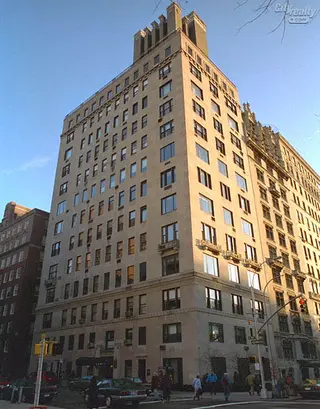 Carter Horsley
Carter HorsleyDec 23, 2011
Carter's Review
This handsome apartment building occupies a prime site on Fifth Avenue directly across from the spectacular Solomon R. Guggenheim Museum. As a result, its long sidestreet façade has dramatic views of the famous Frank Lloyd Wright museum's curves and more privacy and Central Park views than most sidestreet exposures.
Its location in the heart of the Carnegie Hill neighborhood is also very desirable as it is very convenient to several fine private schools and other cultural institutions. A good supermarket is around the corner on Madison Avenue and several attractive restaurants are also nearby on that avenue.
The 14-story building was converted to a cooperative in 1947 and has only 13 apartments. The building, which has a sidestreet entrance as well as a maisonette apartment with its own entrance on sidestreet, is perhaps most notable, however, for its very fine rooftop watertank enclosure, one of the most striking in the city.
In their important book, "New York 1930, Architecture and Urbanism Between The Two World Wars," (Rizzoli International Publications, Inc., 1987), Robert A. M. Stern, Gregory Gilmartin and Thomas Mellins comment highlight this feature:
"Throughout the 1920 s the [Fifth Avenue] buildings declined in individuality and aesthetic distinction, except in the handling of the rooftop silhouette. As long as the dominant model was 998 Fifth Avenue, with its bold cornice decisively concluding the building's composition and acting as a parapet that concealed the typical rooftop jumble of fire stairs, bulkheads, and elevator machine rooms, the Fifth Avenue wall was uniform when viewed from Central Park. But with the greater height permitted apartment hotels along the avenue after 1924, and with the increasingly desirability of penthouses, the way rooftop elements looked became important on narrow lots where the largest elements, such as water tanks, could not be pushed back and were as a result almost as visible as the façades themselves. To solve this problem, [architect] J. E. R. Carpenter pioneered the camouflaging of water tanks and other utilities in tower-like forms that when viewed from the park provided the singular note of individuality along the Fifth Avenue phalanx.
Pennington & Lewis, in their 2 East 88th Street of 1927, transformed the strategy into lyric poetry, using brick piers capped by severe Grecian stone faces staring north and west, phantoms of a skytop Babylon worthy of the pen of Hugh Ferriss [the great architectural draftsman] or the movies of Cecil B. DeMille."
Although the Guggenheim museum generates considerable pedestrian traffic, this area is one of the quietest on Fifth Avenue as parades do not go further north than 86th Street and Central Park road entrances and exits are a few blocks away.

- Co-op built in 1930
- Located in Carnegie Hill
- 13 total apartments 13 total apartments
- 7 recent sales ($1.8M to $60M)
- Doorman

 6sqft delivers the latest on real estate, architecture, and design, straight from New York City.
6sqft delivers the latest on real estate, architecture, and design, straight from New York City.
